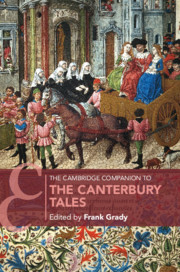Book contents
- The Cambridge Companion to The Canterbury Tales
- The Cambridge Companion to The Canterbury Tales
- Copyright page
- Contents
- Illustrations
- Contributors
- Preface
- Note on the Text
- Chronology
- Abbreviations
- 1 The Form of the Canterbury Tales
- 2 Manuscripts, Scribes, Circulation
- 3 The General Prologue
- 4 The Knight’s Tale and the Estrangements of Form
- 5 The Miller’s Tale and the Art of Solaas
- 6 The Man of Law’s Tale
- 7 The Wife of Bath’s Prologue and Tale
- 8 The Friar’s Tale and TheSummoner’s Tale in Word and Deed
- 9 Griselda and the Problem of the Human in The Clerk’s Tale
- 10 The Franklin’s Symptomatic Sursanure
- 11 The Pardoner and His Tale
- 12 The Prioress’s Tale
- 13 The Nun’s Priest’s Tale
- 14 Moral Chaucer
- 15 Chaucer’s Sense of an Ending
- 16 Postscript: How to Talk about Chaucer with Your Friends and Colleagues
- Further Reading
- Index
- Cambridge Companions to …
1 - The Form of the Canterbury Tales
Published online by Cambridge University Press: 21 August 2020
- The Cambridge Companion to The Canterbury Tales
- The Cambridge Companion to The Canterbury Tales
- Copyright page
- Contents
- Illustrations
- Contributors
- Preface
- Note on the Text
- Chronology
- Abbreviations
- 1 The Form of the Canterbury Tales
- 2 Manuscripts, Scribes, Circulation
- 3 The General Prologue
- 4 The Knight’s Tale and the Estrangements of Form
- 5 The Miller’s Tale and the Art of Solaas
- 6 The Man of Law’s Tale
- 7 The Wife of Bath’s Prologue and Tale
- 8 The Friar’s Tale and TheSummoner’s Tale in Word and Deed
- 9 Griselda and the Problem of the Human in The Clerk’s Tale
- 10 The Franklin’s Symptomatic Sursanure
- 11 The Pardoner and His Tale
- 12 The Prioress’s Tale
- 13 The Nun’s Priest’s Tale
- 14 Moral Chaucer
- 15 Chaucer’s Sense of an Ending
- 16 Postscript: How to Talk about Chaucer with Your Friends and Colleagues
- Further Reading
- Index
- Cambridge Companions to …
Summary
This chapter explores the varying meanings and importance of form in the Canterbury Tales. Overall, the focus is on Chaucer’s understanding of form as integral to interpretation. The opening section contextualizes Chaucer’s approach to form within later medieval poetics, contrasting ideas of formal perfection and imperfection in the work of Dante and the Pearl-poet with Chaucer’s responsive and unpredictable forms. The Canterbury Tales is compared with tale-collections by Gower and Boccaccio, and with Chaucer’s other tale-collections – the ‘Monk’s Tale’ and the Legend of Good Women. The chapter explores the interplay and juxtaposition of forms both across the Tales, and within an individual tale (The Nun’s Priest’s Tale). Moving to a micro-level, it analyses one specific form – rhyme royal – by close-reading several stanzas from The Man of Law’s Tale. Finally it argues that Chaucer problematizes the conventional allegorical idea of seeing through form to reach meaning, suggesting instead that form and content cannot be divided. Meaning is inherent in Chaucer’s complex, kinetic, and, above all, multiple forms.
Keywords
- Type
- Chapter
- Information
- The Cambridge Companion to The Canterbury Tales , pp. 1 - 20Publisher: Cambridge University PressPrint publication year: 2020

